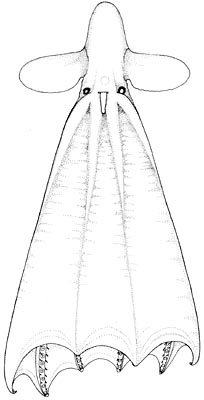Cirrothauma murrayi
Richard E. Young and Michael VecchioneIntroduction
C. murrayi is virtually blind. The eye lacks a lens; the retina is reduced and continuous with a cornea. The eye is embedded within the gelatinous tissue of the head without connection to the surface. Nevertheless, the eye still functions as a simple photoreceptor that cannot form images (Aldred et al, 1983). This species is worldwide in distribution and occupies great depths primarily between 1500 and 4500 m (Nesis, 1982/87) although it has been captured at the surface in an ice hole in the Arctic Ocean (Aldred et al., 1983).
Diagnosis
A Cirrothauma ...
- with reduced eyes lacking lenses.
Characteristics
- Eyes
- Each eye small and without lens.
- Outer eyelid absent.
 image info
image info Figure. Eye and white body of C. murrayi. Drawing from Chun, 1910.
The back, purple part of the eye is the pigmented retina which is continuous in the front with a transparent cornea (this is not homologous with the incirrate cornea). The eye therefore is a sphere with a smooth, curved window in front. The eye is completely embedded in the gelatinous tissue of the head without any external opening. The eye, however is surrounded by a space that is filled with water. An iris and ciliary body are absent. Most of the retina has rhabdomes of normal form that are apparently functional. The purple-colored spherical structure behind the eye (at right in the figure) is the white body. (from Chun, 1910, Aldred, et al., 1983).
- Suckers
- Proximal 6 suckers sessile.
- Suckers over most of arm tiny on long, spindle-shaped, gelatinous stalks.
- Sucker orifice minute or absent.
- Acetabulum absent.
 image info
image info Figure. Oral view of C. murrayi, type illustration, 37 mm ML. Drawing from Chun (1910).
 image info
image info  image info
image info Figure. Left - Longitudinal section through a sucker of C. murrayi, male, 155 mm ML, North Atlantic. Drawing from Aldred et al (1983). The drawing is a section through the tiny sucker that lies at the tip of the long, swollen stalks. The structure labeled "cylinder"appears to consist of acid mucopolysaccharide-containing tissue and internal to it are many small bundles of longitudinal muscle fibres (not shown in drawing) (Aldred et al, 1983). Right - Side view of a portion of an arm of C. murrayi showing the swollen sucker stalks and the tiny apical suckers, fresh (=unfixed) octopod. Photograph by M. Vecchione, R/V G. O. Sars, Mar-Eco cruise, central North Atlantic.
- Web
- Distal web attachments to each arm symmetrical.
- Photophores
- Possible photophore: a small structure located internally at the base of each sucker stalk.
Comments
The above description is taken from Chun (1910) and Aldrich, et al. (1983). More details of the description can be found here.
The reduced suckers are still thought to provide suction but clearly by a somewhat different mechanism than typically seen in octopods. Contraction of the radial muscles near the center of a flat infundibulum that adheres to a surface, should provide suction. Aldred et al. (1983) suggest, however, that adhesion may arise from capillary action of the many minute tubes that make up the cuticle of the infundibulum and that this is especially effective in very deep-living octopods.
Distribution
Type locality: The North Atlantic at 48°24'N, 36°53'W. It is known from the Pacific, Atlantic and Arctic Oceans. In the Northeast Atlantic one study that captured 27 individuals, found they occurred from 2430-4846 m depth, with most captures below 3000 m (Collins, et al., 2001)
References
Aldred, R. G., M. Nixon and J. Z. Young. 1983. Cirrothauma murrayi Chun, a finned octopod. Phil. Trans. Roy. Soc. Lond., 301: 1-54.
Collins, M. A., C. Yau, L. Allcock and M. H. Thurston. 2001. Distribution of deep-water benthic and bentho-pelagic cephalopods from the north-east Atlantic. Jour. Mar. Biol. Ass. U.K., 81: 105-117.
Chun, C. 1910. Die Cephalopoden. Oegopsida. Wissenschaftliche Ergebnisse der Deutschen Tiefsee-Expedition, "Valdivia" 1898-1899, 18: 1-522 + Atlas.
Nesis, K. N. 1982/87. Abridged key to the cephalopod mollusks of the world's ocean. 385+ii pp. Light and Food Industry Publishing House, Moscow. (In Russian.). Translated into English by B. S. Levitov, ed. by L. A. Burgess (1987), Cephalopods of the world. T. F. H. Publications, Neptune City, NJ, 351pp.
Title Illustrations
| Scientific Name | Cirrothauma murrayi |
|---|---|
| Location | Antarctic waters |
| Creator | E. McSweeny |
| Copyright | © 1996 E. McSweeny |
| Scientific Name | Cirrothauma murrayi |
|---|---|
| Location | North Atlantic |
| Reference | Aldred, R. G., M. Nixon and J. Z. Young. 1983. Cirrothauma murrayi Chun, a finned octopod. Phil. Trans. Roy. Soc. Lond., 301: 1-54. |
| Sex | Male |
| Size | 155 mm ML |
| Copyright | © 1983 R.G. Aldred et al. |
About This Page
Richard E. Young
Dept of Oceanography
University of Hawaii
Honolulu, Hawaii 96822
USA
National Marine Fisheries Service
Systematics Laboratory
National Museum of Natural History
Washington, D. C. 20560
USA
Page copyright © 2003 Richard E. Young and
- First online 13 May 2003
Citing this page:
Young, Richard E. and Vecchione, Michael. 2003. Cirrothauma murrayi . Version 13 May 2003 (under construction). http://tolweb.org/Cirrothauma_murrayi/20099/2003.05.13 in The Tree of Life Web Project, http://tolweb.org/










